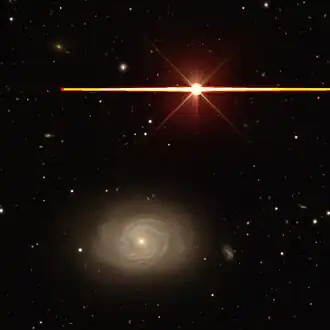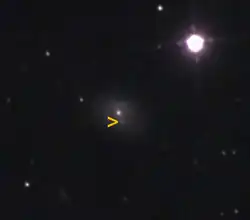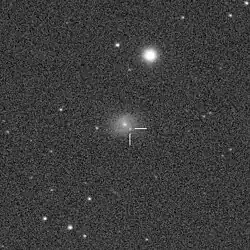NGC 4995
| NGC 4995 | |
|---|---|
 legacy surveys image of NGC 4995, with KY Virginis above (red star) | |
| Observation data (J2000 epoch) | |
| Constellation | Virgo |
| Right ascension | 13h 09m 40.6390105944s |
| Declination | −07° 50′ 00.223871892″ |
| Distance | 85 Mly (26 Mpc)[1] |
| Apparent magnitude (V) | 11.2[2] |
| Apparent magnitude (B) | 12.0[2] |
| Characteristics | |
| Type | SAB(r)b D 2013MNRAS.431.3060E |
| Other designations | |
| UGCA 329, MCG -01-34-007, PGC 45643 | |
References: [3] | |
NGC 4995 is a "moderately bright and large galaxy" in the constellation Virgo.[4] It is a member of the NGC 4995 Group of galaxies, which is a member of the Virgo II Groups, a series of galaxies and galaxy clusters strung out from the southern edge of the Virgo Supercluster.[3]
One supernova has been observed in NGC 4995. SN 2023gfo (Type II, mag 16.192) was discovered by ATLAS on 20 April 2023.[5][6]
Gallery
-
 Supernova 2023gfo in NGC 4995 as seen on 2023-04-21 10:17 UT.
Supernova 2023gfo in NGC 4995 as seen on 2023-04-21 10:17 UT. -
 Supernova 2023gfo in NGC 4995 imaged UTC 2023-04-24T03:06
Supernova 2023gfo in NGC 4995 imaged UTC 2023-04-24T03:06
References
- ^ "Distance Results for NGC 4995". NASA/IPAC Extragalactic Database. Retrieved 2023-04-21.
- ^ a b "Revised NGC Data for NGC 4995". spider.seds.org. Retrieved 2023-04-21.
- ^ a b "The Virgo II Groups". Atlas of the Universe. Archived from the original on July 22, 2012. Retrieved August 9, 2022.
- ^ Clark, Maurice. "NGC 4995". Texas Tech University. Archived from the original on August 9, 2022. Retrieved August 9, 2022.
- ^ 2023gfo in NGC 4995 (David Bishop)
- ^ Transient Name Server: 2023gfo